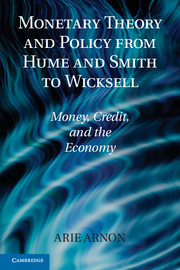Book contents
- Frontmatter
- Dedication
- Contents
- List of Illustrations
- List of Tables
- Preface
- Introduction
- Part one Analytical and Historical Foundations
- Part two Debating Monetary Theory under Inconvertibility
- 5 New Reality
- 6 The Early Round of the Bullion Debate 1800–1802
- 7 Thornton on Inconvertibility and Central Banking
- 8 Ricardo versus Bosanquet
- 9 “Credit Theories of Money” in Exchange and Intermediation
- Part three Debating
- Part four The Road to Defensive Central Banking
- Part five A New Beginning
- Bibliography
- Author Index
- Subject Index
6 - The Early Round of the Bullion Debate 1800–1802
Boyd versus Baring
Published online by Cambridge University Press: 05 July 2014
- Frontmatter
- Dedication
- Contents
- List of Illustrations
- List of Tables
- Preface
- Introduction
- Part one Analytical and Historical Foundations
- Part two Debating Monetary Theory under Inconvertibility
- 5 New Reality
- 6 The Early Round of the Bullion Debate 1800–1802
- 7 Thornton on Inconvertibility and Central Banking
- 8 Ricardo versus Bosanquet
- 9 “Credit Theories of Money” in Exchange and Intermediation
- Part three Debating
- Part four The Road to Defensive Central Banking
- Part five A New Beginning
- Bibliography
- Author Index
- Subject Index
Summary
Introduction
As we saw in Chapter 5, the Restriction Period began in England in February 1797 when, under the shadow of a run on the banking system, the sovereign suspended the specie convertibility of Bank of England notes. The suspension of cash payments remained in effect until 1821 and marked a crucial turning point for both banking theory and monetary policy.
The Bank of England, as we recall from Chapters 2 and 5, was a private institution with privileges; it was the only bank in London whose charter permitted it to issue notes within the city and its vicinity. The London private banks did not issue notes but dealt with all other aspects of banking; the country banks outside London faced almost no legal restrictions concerning note-issuing. The heavily capitalized Bank of England, which financed public expenditure and held reserves for the other banks, thus became the pivot of the British banking system. In hindsight, it was the Bank’s powerful position, particularly concerning reserves, its monopoly in note-issuing in London, and its lack of understanding of its consequent responsibilities that made it the focal point of a controversy within the British economic system that lasted over seventy years.
The French War years around the turn of the nineteenth century witnessed a period of intense economic debate in England. The debates during the Restriction about the complicated relationship between inflation, the exchanges, and monetary control came to be known as the Bullion Debate, referring to a prevalent Restriction-era conversation about the reasons for the fluctuating market price of gold and the advisability of a return to specie convertibility. The Bullionists were critical of the Bank of England and supported an early return to convertibility; the anti-Bullionists defended the Bank and inconvertibility.
- Type
- Chapter
- Information
- Monetary Theory and Policy from Hume and Smith to WicksellMoney, Credit, and the Economy, pp. 73 - 95Publisher: Cambridge University PressPrint publication year: 2010

